
An extensive range of styles, methods, and media have been used in Indian art throughout its long, rich, and varied history. Watercolor painting stands out as a compelling and bright genre among India's many other creative mediums. The vibrant hues, minute details, and intensity of emotions that are frequently associated with Indian art can only be successfully conveyed by watercolors. In this blog article, we'll go deep into the world of Indian watercolor paintings, learning about its history, methods, famous creators, and the cultural value they have.
The Rich History of Indian Art
Let's pause to acknowledge the lengthy history of Indian art before we go into the world of watercolor paintings. Each dynasty and period that shaped Indian art's development left its own particular imprint on the country's aesthetic environment. India's cultural past is as diverse as its population, ranging from the prehistoric cave paintings at Ajanta and Ellora to the Mughal miniature paintings and the thriving folk art forms.
Indian art's ability to smoothly meld tradition and modernity is one of its most interesting features. While ancient art styles have been preserved and passed down through the years, modern artists continue to innovate and push the limits of creative expression. One such media used in the Indian art scene that has seen both tradition and innovation is watercolor painting.
The Allure of Watercolor Paintings

Watercolor painting is a medium that uses water-soluble pigments to create artworks. The colors are transparent and are built up in layers to achieve depth and vibrancy. This medium is particularly well-suited for capturing the essence of Indian art, as it allows for the expression of vibrant hues and intricate details.
Vivid Colors: One of the defining characteristics of Indian art is its vibrant use of color. Watercolors excel in capturing the rich, bold colors often seen in Indian textiles, festivals, and daily life. From the deep blues of the ocean to the warm reds of spices, watercolors can evoke the sensory experiences of India.
Intricate Details: Indian art is known for its intricate and ornate designs. Whether it's the delicate patterns of henna tattoos or the intricacies of architectural motifs, watercolor's fine brushwork and layering make it an ideal medium for capturing these details.
Emotional Depth: Indian art often conveys deep emotions, whether it's the devotion of religious art or the celebration of life in festive scenes. Watercolors' transparent layers allow artists to infuse their work with emotion, creating a connection with the viewer.
The History of Watercolor Painting in India
Watercolor painting has a long history in India, dating back to ancient times. It was used in various forms for manuscripts, depicting mythological stories, and illustrating botanical and zoological studies. The Mughal Empire, in particular, played a significant role in popularizing watercolor painting in India. Mughal miniature paintings, characterized by their intricate details and exquisite use of color, remain a testament to the artistic brilliance of that era.
During British colonial rule, watercolor painting gained further prominence in India. British artists brought the medium to the country, and Indian artists began to adopt and adapt it to their own styles and subjects. This period witnessed a fusion of Western techniques with traditional Indian art forms.
Prominent Indian Watercolor Artists

Several prominent Indian artists have made significant contributions to the world of watercolor painting:
- Raja Ravi Varma (1848-1906): Often referred to as the father of modern Indian art, Raja Ravi Varma's contribution to Indian watercolor painting is monumental. He combined Western techniques with Indian themes, producing iconic works such as "Shakuntala" and "Hamsa Damayanti." His realistic depictions of Indian mythology and society earned him widespread acclaim.
- Abanindranath Tagore (1871-1951): A key figure in the Bengal School of Art, Abanindranath Tagore was known for his role in reviving traditional Indian art forms. He used watercolors to create works that celebrated India's rich cultural heritage and helped pave the way for the Indian modern art movement.
- Jamini Roy (1887-1972): Jamini Roy is renowned for his bold and innovative use of watercolors. He drew inspiration from folk art traditions, creating a distinct style that celebrated the simplicity and vibrancy of rural life. His paintings, often featuring rural subjects and mythological figures, are characterized by flat colors and bold lines.
- A. Ramachandran (b. 1935): A contemporary artist, A. Ramachandran is known for his watercolor paintings that explore the nuances of Indian mythology and culture. His works are characterized by intricate detailing and a deep connection to Indian traditions.
Watercolor Techniques in Indian Art
Indian watercolor artists employ a variety of techniques to create their distinctive works. These techniques often involve a combination of traditional methods and innovative approaches:
- Layering: Watercolors are built up through layers of transparent colors. This technique allows artists to achieve depth and luminosity in their paintings. Each layer adds to the richness of the final piece.
- Wash Technique: Indian artists often use the wash technique to create vibrant backgrounds or to establish a mood in their paintings. By varying the intensity of the wash, they can create dramatic contrasts or subtle gradients.
- Fine Brushwork: Intricate detailing is a hallmark of Indian watercolor art. Artists use fine brushes to add delicate patterns, textures, and intricate designs to their works.
- Color Mixing: The art of color mixing is crucial in watercolor painting. Indian artists are skilled in blending colors to create harmonious palettes that evoke the essence of their subjects.
- Use of White Space: The strategic use of white space is a technique that adds emphasis and luminosity to specific areas of a painting. It can make colors appear more vibrant and highlights more pronounced.
- Gold Leaf Embellishments: Some artists incorporate gold leaf or metallic paints into their watercolor works to add a touch of opulence and highlight certain elements of the composition.
Themes in Indian Watercolor Paintings

Indian watercolor paintings cover a wide range of themes, reflecting the diversity of Indian culture, history, and society. Some common themes include:
- Mythology and Religion: Many watercolor paintings in India depict scenes from Hindu mythology, showcasing gods, goddesses, and epic tales. These paintings often have a spiritual and devotional significance.
- Landscapes and Nature: India's varied landscapes, from lush forests to arid deserts, provide abundant inspiration for artists. Watercolors capture the natural beauty of the country's diverse terrain.
- Daily Life: Artists often portray scenes from everyday life in India, offering glimpses into the colorful and bustling streets, marketplaces, and villages. These paintings provide a window into the culture and traditions of the people.
- Portraits and Figures: Watercolors are used to create portraits of individuals from different walks of life, from kings and queens to common people. These portraits often reveal the personality and character of the subjects.
- Festivals and Celebrations: Indian festivals, with their vibrant colors and joyous atmosphere, are a favorite subject for watercolor artists. These paintings capture the festive spirit and cultural significance of these events.
- Wildlife and Flora: India's rich biodiversity is a frequent theme in watercolor paintings. Artists depict native animals, birds, and plants with meticulous attention to detail.
Cultural Significance of Watercolor Art in India
Watercolor painting in India goes beyond being a mere artistic medium; it holds cultural significance and contributes to the preservation of traditions and narratives. Here are some ways in which watercolor art is culturally significant:
- Preservation of Heritage: Watercolor paintings often depict traditional art forms, historical events, and cultural practices. They serve as visual records, helping preserve India's rich heritage for future generations.
- Religious Devotion: Many watercolor paintings have religious themes and are used for worship and meditation. These artworks play a crucial role in maintaining spiritual connections and reinforcing religious beliefs.
- Education and Awareness: Watercolor paintings are used as educational tools to teach history, culture, and environmental conservation. They make learning engaging and accessible, especially for younger generations.
- Promotion of Tourism: Watercolor paintings often portray India's picturesque landscapes and architectural marvels. They promote tourism by showcasing the country's beauty and cultural attractions.
- Expression of Identity: Watercolor art allows artists to express their individuality and cultural identity. It serves as a platform for artists to explore and convey their personal experiences and perspectives.
- Cross-Cultural Exchange: Indian watercolor art has garnered international acclaim and is a means of cultural exchange. It fosters connections between India and the global art community, enriching artistic dialogues.

Read More: Tips for Artists: Learn the impeccable craft of Watercolor Paintings
Conclusion:
Indian watercolor painting is a vibrant and captivating genre that beautifully encapsulates the essence of India's culture, history, and diversity. From ancient manuscripts to modern masterpieces, watercolors have played a significant role in India's artistic journey. The medium's ability to convey vivid colors, intricate details, and deep emotions makes it a powerful tool for storytelling and cultural preservation.
As we explore the world of Indian watercolor art, we discover a rich tapestry of themes, techniques, and artists who have left an indelible mark on the artistic landscape. Whether depicting mythological tales, everyday life, or the natural beauty of the land, watercolors offer a window into the heart and soul of India.
In an ever-evolving world of art, Indian watercolor paintings continue to enchant and inspire, bridging the gap between tradition and innovation, and connecting people across cultures through the universal language of art. It is a world worth exploring, where each stroke of the brush tells a story, and every color carries the vibrancy of a nation's heritage.





















